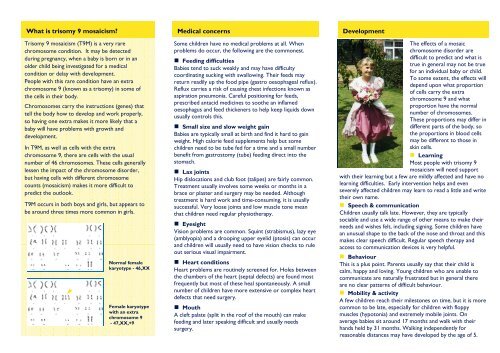Trisomy 9 mosaicism QFN.pub - Unique - The Rare Chromosome ...
Trisomy 9 mosaicism QFN.pub - Unique - The Rare Chromosome ...
Trisomy 9 mosaicism QFN.pub - Unique - The Rare Chromosome ...
Create successful ePaper yourself
Turn your PDF publications into a flip-book with our unique Google optimized e-Paper software.
What is trisomy 9 <strong>mosaicism</strong>?<br />
<strong>Trisomy</strong> 9 <strong>mosaicism</strong> (T9M) is a very rare<br />
chromosome condition. It may be detected<br />
during pregnancy, when a baby is born or in an<br />
older child being investigated for a medical<br />
condition or delay with development.<br />
People with this rare condition have an extra<br />
chromosome 9 (known as a trisomy) in some of<br />
the cells in their body.<br />
<strong>Chromosome</strong>s carry the instructions (genes) that<br />
tell the body how to develop and work properly,<br />
so having one extra makes it more likely that a<br />
baby will have problems with growth and<br />
development.<br />
In T9M, as well as cells with the extra<br />
chromosome 9, there are cells with the usual<br />
number of 46 chromosomes. <strong>The</strong>se cells generally<br />
lessen the impact of the chromosome disorder,<br />
but having cells with different chromosome<br />
counts (<strong>mosaicism</strong>) makes it more difficult to<br />
predict the outlook.<br />
T9M occurs in both boys and girls, but appears to<br />
be around three times more common in girls.<br />
Normal female<br />
karyotype - 46,XX<br />
Female karyotype<br />
with an extra<br />
chromosome 9<br />
- 47,XX,+9<br />
Medical concerns<br />
Some children have no medical problems at all. When<br />
problems do occur, the following are the commonest.<br />
Feeding difficulties<br />
Babies tend to suck weakly and may have difficulty<br />
coordinating sucking with swallowing. <strong>The</strong>ir feeds may<br />
return readily up the food pipe (gastro oesophageal reflux).<br />
Reflux carries a risk of causing chest infections known as<br />
aspiration pneumonia. Careful positioning for feeds,<br />
prescribed antacid medicines to soothe an inflamed<br />
oesophagus and feed thickeners to help keep liquids down<br />
usually controls this.<br />
Small size and slow weight gain<br />
Babies are typically small at birth and find it hard to gain<br />
weight. High calorie feed supplements help but some<br />
children need to be tube fed for a time and a small number<br />
benefit from gastrostomy (tube) feeding direct into the<br />
stomach.<br />
Lax joints<br />
Hip dislocations and club foot (talipes) are fairly common.<br />
Treatment usually involves some weeks or months in a<br />
brace or plaster and surgery may be needed. Although<br />
treatment is hard work and time-consuming, it is usually<br />
successful. Very loose joints and low muscle tone mean<br />
that children need regular physiotherapy.<br />
Eyesight<br />
Vision problems are common. Squint (strabismus), lazy eye<br />
(amblyopia) and a drooping upper eyelid (ptosis) can occur<br />
and children will usually need to have vision checks to rule<br />
out serious visual impairment.<br />
Heart conditions<br />
Heart problems are routinely screened for. Holes between<br />
the chambers of the heart (septal defects) are found most<br />
frequently but most of these heal spontaneously. A small<br />
number of children have more extensive or complex heart<br />
defects that need surgery.<br />
Mouth<br />
A cleft palate (split in the roof of the mouth) can make<br />
feeding and later speaking difficult and usually needs<br />
surgery.<br />
Development<br />
<strong>The</strong> effects of a mosaic<br />
chromosome disorder are<br />
difficult to predict and what is<br />
true in general may not be true<br />
for an individual baby or child.<br />
To some extent, the effects will<br />
depend upon what proportion<br />
of cells carry the extra<br />
chromosome 9 and what<br />
proportion have the normal<br />
number of chromosomes.<br />
<strong>The</strong>se proportions may differ in<br />
different parts of the body, so<br />
the proportions in blood cells<br />
may be different to those in<br />
skin cells.<br />
Learning<br />
Most people with trisomy 9<br />
<strong>mosaicism</strong> will need support<br />
with their learning but a few are mildly affected and have no<br />
learning difficulties. Early intervention helps and even<br />
severely affected children may learn to read a little and write<br />
their own name.<br />
Speech & communication<br />
Children usually talk late. However, they are typically<br />
sociable and use a wide range of other means to make their<br />
needs and wishes felt, including signing. Some children have<br />
an unusual shape to the back of the nose and throat and this<br />
makes clear speech difficult. Regular speech therapy and<br />
access to communication devices is very helpful.<br />
Behaviour<br />
This is a plus point. Parents usually say that their child is<br />
calm, happy and loving. Young children who are unable to<br />
communicate are naturally frustrated but in general there<br />
are no clear patterns of difficult behaviour.<br />
Mobility & activity<br />
A few children reach their milestones on time, but it is more<br />
common to be late, especially for children with floppy<br />
muscles (hypotonia) and extremely mobile joints. On<br />
average babies sit around 17 months and walk with their<br />
hands held by 31 months. Walking independently for<br />
reasonable distances may have developed by the age of 5.

















